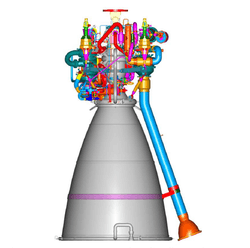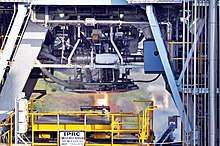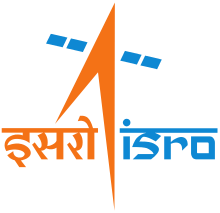CE-20
The CE-20 is a cryogenic rocket engine developed by the Liquid Propulsion Systems Centre, a subsidiary of Indian Space Research Organisation. It has been developed to power the upper stage of the Geosynchronous Satellite Launch Vehicle Mk III.[4] It is the first Indian cryogenic engine to feature a gas-generator cycle.[5] The high thrust cryogenic engine is one of the most powerful upper stage cryogenic engines in the world.[6]
 A computer model of CE-20 | |
| Country of origin | India |
|---|---|
| First flight | June 5, 2017 |
| Designer | LPSC, ISRO |
| Manufacturer | HAL[1] |
| Application | Upper stage booster |
| Status | Active |
| Liquid-fuel engine | |
| Propellant | LOX / LH2 |
| Mixture ratio | 5.05 |
| Cycle | Gas Generator |
| Configuration | |
| Chamber | 1 |
| Nozzle ratio | 100 |
| Performance | |
| Thrust (vac.) | 200 kN (45,000 lbf) |
| Throttle range | 180–220 kN (40,000–49,000 lbf) |
| Chamber pressure | 6 MPa (870 psi) |
| Isp (vac.) | 443 ± 3 seconds (4.344 ± 0.029 km/s) |
| Burn time | 640-800 seconds |
| Dimensions | |
| Dry weight | 588 kg (1,296 lb) |
| Used in | |
| Upper stage of GSLV Mk.III | |
| References | |
| References | [2][3] |
Overview
The CE-20 is the first Indian cryogenic engine to feature a gas-generator cycle.[7] The engine produces a nominal thrust of 200 kN, but has an operating thrust range between 180 kN to 220 kN and can be set to any fixed values between them. The combustion chamber burns liquid hydrogen and liquid oxygen at 6 MPa with 5.05 engine mixture ratio.[2][3] The engine has a thrust-to-weight ratio of 34.7 and a specific impulse of 444 seconds (4.35 km/s) in vacuum.
Development and Testing

- On 28 April 2015, CE-20 cleared a 635 seconds long duration hot test at IPRC, Mahendragiri test facility. This test was preceded by two cold start tests and four short duration hot tests.[8]
- On 16 July 2015, the first developmental CE-20 engine 'E1' was successfully endurance hot tested at ISRO Propulsion Complex, Mahendragiri for a duration of 800 seconds with Mixture Ratio Controller (MRC) in closed loop mode. This duration is approximately 25% more than the engine burn duration in flight. This was tenth development test for CE-20 [9]
- On 10 August 2015, a short duration (5.7 seconds) hot test on the CE20 engine was done to demonstrate the successful engine ignition with tank pressure conditions as in flight.[10]
- On 19 February 2016, the second developmental CE-20 engine 'E2'[11] was hot-tested for a duration of 640 seconds with Mixture Ratio Controller (MRC) in closed loop mode at ISRO Propulsion Complex, Mahendragiri.[12][13][14]
- On 03 December 2016, flight acceptance test of 25 seconds in high altitude conditions was carried out on third developmental CE-20 engine (E3).[15][16][17] It was successfully flown on the first developmental flight 'D1' of the GSLV Mk-III on 5 June 2017.[18]
- On 25 January 2017, CE-20 engine E2[17] integrated with development stage for GSLV Mk III, C25 'D' was tested for duration of 50 seconds.[19]
- On 17 February 2017, CE-20 engine E2[17] integrated with development stage for GSLV Mk III, C25 'D' was tested for duration of 640 seconds.[20]
- On 11 October 2018, CE-20 engine E6 completed 25 second long flight acceptance test in high altitude conditions for GSLV Mk III M1/Chandrayaan-2 mission[21]
References
- "HAL to produce cryogenic engines for ISRO". The Hindu. 27 April 2013.
- "LPSC Handouts at Aer India-2009". Specifications of CE-20. Liquid Propulsion Systems Centre. 13 March 2009. Retrieved 29 August 2009.
- "Aero India 2009, LPSC specification sheet :: IMG_0159". Retrieved 2018-09-12.
- "Indigenous Cryogenic Engine Tested Successfully". www.isro.gov.in.
- K. S. Jayaram (22 February 2016). "India's heavy-lift rocket on track for December debut following engine test". SpaceNews.com.
- Praveen, RS; Jayan, N; Bijukumar, KS; Jayaprakash, J; Narayanan, V; Ayyappan, G (February 2017). "Development of Cryogenic Engine for GSLV MkIII: Technological Challenges". IOP Conference Series: Materials Science and Engineering. 171: 012059. doi:10.1088/1757-899X/171/1/012059.
- R. Ramachandran (22 January 2014). "GSLV MkIII, the next milestone". Frontline.
- Ram, Arun (29 April 2015). "Isro's desi cryogenic engine test successful - Times of India". The Times of India.
- "Indigenously Developed High Thrust Cryogenic Rocket Engine Successfully Ground Tested for a duration for 800 seconds - ISRO". www.isro.gov.in.
- "Year End Review: Achievements of Department of Space during the year 2015". Press Information Bureau, Government of India. Retrieved 12 February 2018.
- "CE 20 Engine of GSLV MKIII successfully hot tested - ISRO". www.isro.gov.in. Retrieved 2018-02-12.
- "ISRO upbeat as indigenous cryo engine passes test". The Hindu. 20 February 2016.
- "ISRO successfully conducts hot test of Cryo CE 20 engine". The Hindu. Press Trust of India. 19 Feb 2016. Retrieved 12 February 2018.
- "ISRO successfully conducts hot test of Cryo CE 20 engine". PTI. 19 Feb 2016. Retrieved 12 February 2018.
- "High Altitude Flight Acceptance Test of CE20 Engine Conducted Successfully". Retrieved 12 February 2018.
- "GSLV engine tested at Mahendragiri". The Hindu. 3 December 2016.
- "Department of Space Outcome Budget 2016-17" (PDF). Retrieved 12 October 2018.
- Malik, Tariq (5 June 2017). "India Just Launched Its Heaviest & Most Powerful Rocket Yet". Space.com. Retrieved 7 June 2017.
- "ISRO Successfully Tests C25 Cryogenic Upper Stage of GSLV MkIII - ISRO". www.isro.gov.in. Retrieved 2018-10-12.
- "ISRO Successfully Tests its Cryogenic Stage (C25) for GSLV MkIII for the Flight Duration - ISRO". www.isro.gov.in. Retrieved 2018-10-12.
- "ISRO successfully tests Cryogenic Engine (CE-20) for GSLV Mk-III / Chandrayaan-2 Mission - ISRO". www.isro.gov.in. Retrieved 2018-10-12.
External links
- India test-fires indigenous cryo engine for 800 seconds
- LPSC handouts during Aero India-2009 with Ce-20 specifications
- LPSC handouts during Aero India-2009 with specifications of all Liquid-fueled engines of India
- Status of CE-20 in Space Transportation/GSLV - Mk III of ISRO's 2008-09 Annual Report
- http://www.thehindu.com/sci-tech/science/isro-upbeat-as-indigenous-cryo-engine-passes-test/article8258313.ece#

